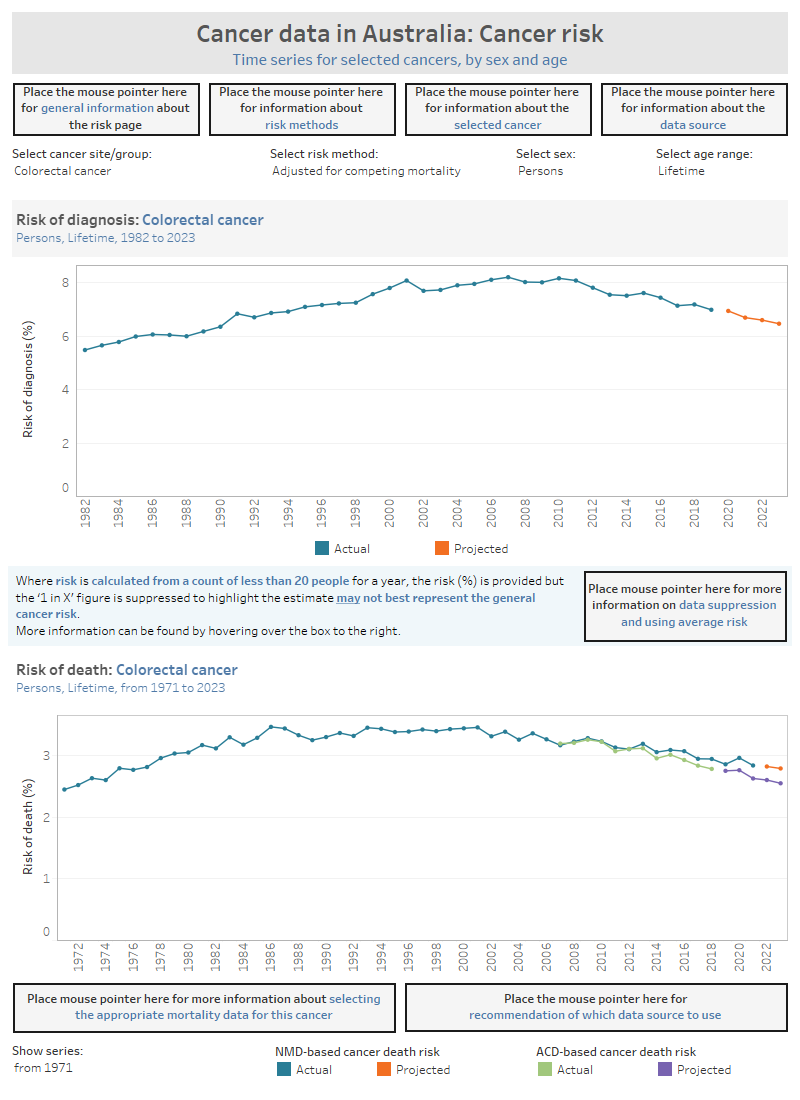Cancer risk data visualisation
For many different cancers, this data visualisation provides cancer incidence and mortality risk data by age. Help with terms, and information about the data, is available by placing the mouse pointer over the icons found near the top of the page. Additional guidance about the risk adjusted for competing mortality and risk unadjusted for competing mortality is located in cancer data commentary number 1 and the methods section.
In this year’s release, cancer mortality statistics from the Australian Cancer Database accompany the mortality data from the National Mortality Database. Please read cancer data commentary number 8 for more information about cancer mortality data investigations. General assistance of how to choose which source to use for reporting on selected cancers is found within the data visualisation. Recommendations of which data source to use are also available within the data visualisation, and Cancer data commentary 8b provides information about how these recommendations were made and associated complexities of mortality reporting with two data sources available.
Advice about using the mortality data is also available by hovering the cursor above the “please read here for more information about using mortality data” box.
This cancer risk visualisation contains two figures. The visualisation presents statistics for the selected cancer and provides statistics by sex.
Figure 1 is a line graph that contains information on the risk of cancer diagnosis (adjusted or unadjusted for competing mortality) for the selected cancer and age range from 1982 to the most recent year available for reporting at the time of release. Please read cancer data commentary C1 for more information about cancer risk and the adjusted and unadjusted for competing mortality concepts.
Figure 2 is a line graph that contains information on the risk of death from cancer (adjusted or unadjusted for competing mortality) for the selected cancer and age range historically up to the most recent year available for reporting at the time of release. Two series are presented in the graph: a line graph for each of risk estimates using NMD-based and ACD-based cancer death counts.
The visualisation includes information about many different cancers and the statistics within this visualisation are available in Excel format within the Data section of this report.

Cancer risk data are available as supplementary tables.
ABS (Australian Bureau of Statistics) 2018. Population projections, Australia, 2017 (base) – 2066. ABS cat. no. 3222.0. Canberra: ABS.
AIHW (Australian Institute of Health and Welfare) 2019. BreastScreen Australia monitoring report 2018. Cancer series no.127. Cat no. CAN128. Canberra: AIHW
Al-Marhoon M, Osman A, Kamal M and Shokier A 2011. Incidental vs symptomatic renal tumours: Survival outcomes. Arab Journal of Urology 9(1): 17–21.
Brenner H and Gefeller O 1996. An alternative approach to monitoring cancer patient survival. Cancer78:2004–10.
Dickman PW 2004. Estimating and modelling relative survival using SAS. Stockholm: Karolinska Institutet. Viewed 26 May 2020.
Ederer F & Heise H 1959. Instructions to IBM 650 programmers in processing survival computations. Methodological note.
Greenwood M 1926. The errors of sampling of the survivorship table. Reports on public health and medical subjects. Vol 33. London: Her Majesty’s Stationery Office.
Jensen O, Parkin D, MacLennan R, Muir C & Skeet R (eds) 1991. Cancer registration: principles and methods. IARC scientific publications no. 95. Lyon: IARC.
Luke C, Tracey E, Stapleton A and Roder D 2010. Exploring contrary trends in bladder cancer incidence, mortality and survival: implications for cancer research and cancer control. Internal Medicine Journal 40:357–62.
Qaseem A, Usman N, Jayaraj J S, et al. (September 02, 2019) Cancer of Unknown Primary: A Review on Clinical Guidelines in the Development and Targeted Management of Patients with the Unknown Primary Site. Cureus 11(9): e5552. doi:10.7759/cureus.5552
Skuladottir H & Olsen JH 2003. Conditional survival of patients with the four major histologic subgroups of lung cancer in Denmark. Journal of Clinical Oncology 21(16):3035–40.
Smith D Supramaniam R, Marshall V and Armstrong B 2008. Prostate cancer and prostate specific antigen testing in New South Wales. Medical Journal of Australia 189(6): 315–18.
Vaccarella S, Franceschi S, Bray F, Wild C, Plummer M and Dal Maso L 2016. The increase in thyroid cancer may be due to an increase in medical surveillance and the introduction of new diagnostic techniques, such as neck ultrasonography. The New England Journal of Medicine 375: 614–17.


